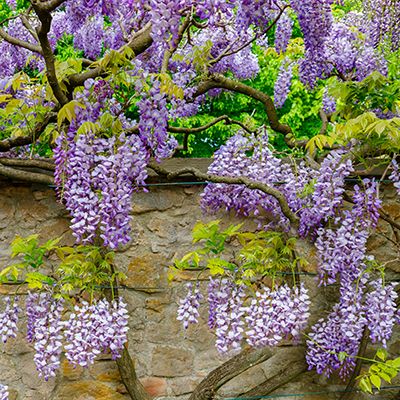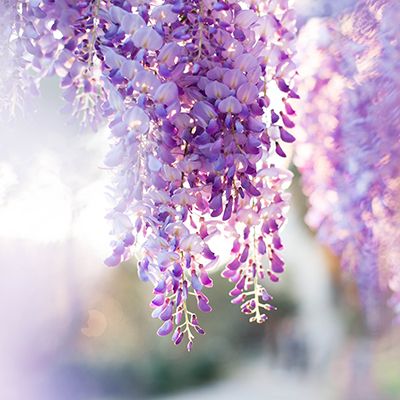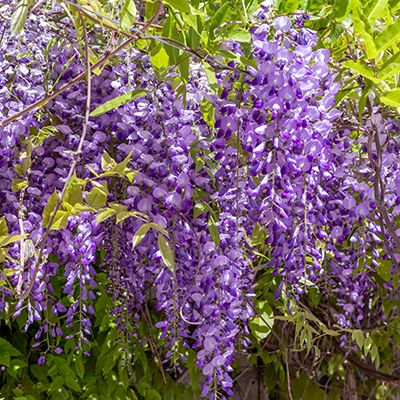


Wisteria
Wisteria is usually grown as a vine, but it may also be grown as a tree, shrub or groundcover. Wisteria grows vigorously when placed in a suitable environment and many people under estimate the size of supports required holding the plant. Four inch by four inch vertical posts with two by four inch laterals are the minimum size for Wisteria vines. Some gardeners will substitute one inch galvanized pipe or heavy gauge wire for the two by four laterals. The vines are capable of twining around their supports, but usually they are tied in position until they have formed a rigid framework.
Wisteria plants need a soil that drains well and is not overly alkaline (see Soils Care Guide for improving clay soils). Use cutting grown or grafted plants. Seedling plants may take from 7 to 9 years before they bloom. Wisteria vines should be allowed to grow until they reach a desired height. Select 2 or 3 of the best stems on the vine and remove the rest at the graft or at ground level. The 2 or 3 are then tied to the vertical support which is already in place. Plant the Wisteria as outlined in the Planting Trees and Shrubs Care Guide.
Rub off any green sprouts which develop along the 2 or 3 vertical stems. Also remove any sprouts which form at the base. During the growing season, long sprouts will develop at the top. These sprouts can be spread out to cover the top of a gazebo or bundled together to form a garland like structure over a porch or garage entrance. At the end of the growing season when the leaves have dropped, trim the new sprouts to the best 4 or 5 on the gazebo and the best 3 or 4 on the garland. All others are cut off back at the original height level. The following year, there will be vast amounts of lateral growth on your framework as well as continuing forward growth. Continue to trim new growth until it covers the gazebo as desired. Long streamer growth over archways and doorways should be cut back so it does not become tangled in the basic framework. During the winter, cut all the lateral growth growing off the framework branches back to 2 or 3 buds on these lateral branches. Each year, the Wisteria will be pruned in the same way; all laterals cut back to 2 or 3 buds. When the vine has grown to the desired length, cut the tip off at a suitable, lateral bud.
Wisterias grow best in full sun, although the Chinese Wisteria (W. sinensis) will bloom with only a half day sun. The top 3 to 4 inches of soil should be allowed to dry between watering, but when irrigating the plants, water should go down 12 to 16 inches. Fertilize once a year about the 4th of July with Master Nursery Rose and Flower Food.
If the Wisteria stops blooming or has very few blooms, be sure that you are not pruning too short and cutting off the flower buds. If you prune in January, you will see some plump flower buds on the lateral growth. Do not cut those off. If you are pruning properly and not getting flowers, stop fertilizing for one growing season. If the vine still does not bloom, you may have to stress the plant by root pruning it. After Wisterias have bloomed, some of the flowers will produce brown seed pods 6 to 9 inches long. If left on the plant, the pods will explode, discharging the seeds into the garden. Most will sprout and develop a long tap root. These seedlings should be rogued out before they become well established.
Wisterias are seldom troubled by insects or disease. If aphids are a problem, spray with Safer Insect Killing Soap, Master Nursery Pest Fighter or Sevin. Occasionally, the plants may become infected with a virus for which there is no cure, but is usually not fatal.
Tree shaped Wisteria are best purchased in that form. You could train a young plant to that shape, but it may be a more labor intensive project than is desirable. Tree Wisterias require the same care as described above. Some gardeners use a two-inch vertical pipe for support because it is less conspicuous and more permanent. Each year, the “tree” will send out more lateral branches or streamers. Eight to ten of these should be selected to be the main framework of the tree. Pinch out any growth trying to become a new tip. The framework (branches), are all cut to the same length and the laterals they develop are allowed to grow. In December/January these laterals are pruned back to 2 or 3 buds as on the vines.
Wisteria can be trained into a shrub if it is begun early. When the plant is about 2-1/2 to 3 feet tall, pinch out the tip back to the second lateral branch. As the plant grows and produces more laterals, pinch out the tips of the laterals when the laterals are about two feet long. Continue this process for the next year or two until the plant is the desired height and width. After that time, trim to maintain the desired shape and prune the laterals as described for the vines to promote blooming.
Wisterias have been used as groundcovers on hillsides. They are planted near the top of the hill and watered and fertilized as described. No pruning is done and the branches are spread out to cover the hill. Usually, the plants are given free reign and allowed to grow at will.
Two species of Wisteria are frequently grown. The Chinese Wisteria (W. sinensis) is most commonly grown in our area because the one-foot long flower clusters open all at once and present a massive display of color and fragrance. Colors are white, blue, and lavender and bloom before the plant leafs out.
Japanese Wisteria (W. floribunda) has 1-1/2 to 3 foot long flower clusters which bloom as the plant starts to leaf out. The flower clusters open first at the top and then gradually down the entire length. The flower show is not as massive as the Chinese Wisteria but lasts for a longer time. Colors are available in white, pink, lavender, blue, and violet. Both species are cared for and pruned in the same manner.
A bit of Wisteria trivia is that the Japanese Wisteria vine twines around its support in a clockwise direction, while the Chinese Wisteria twines in a counterclockwise direction